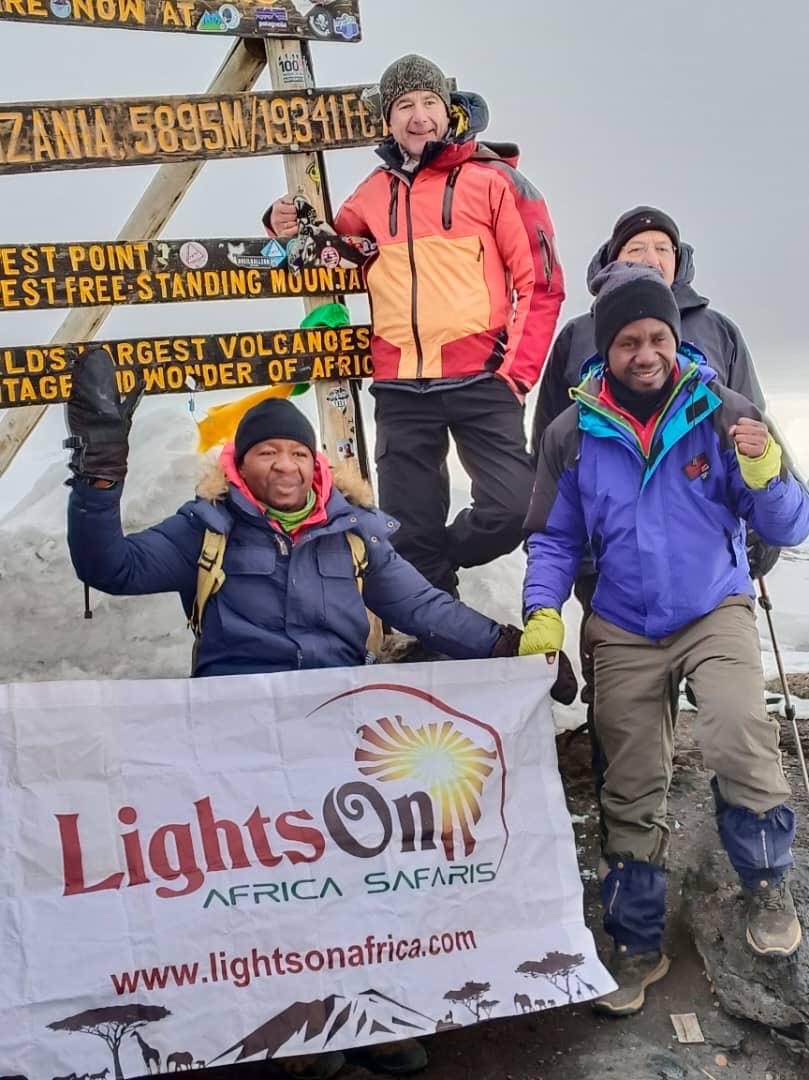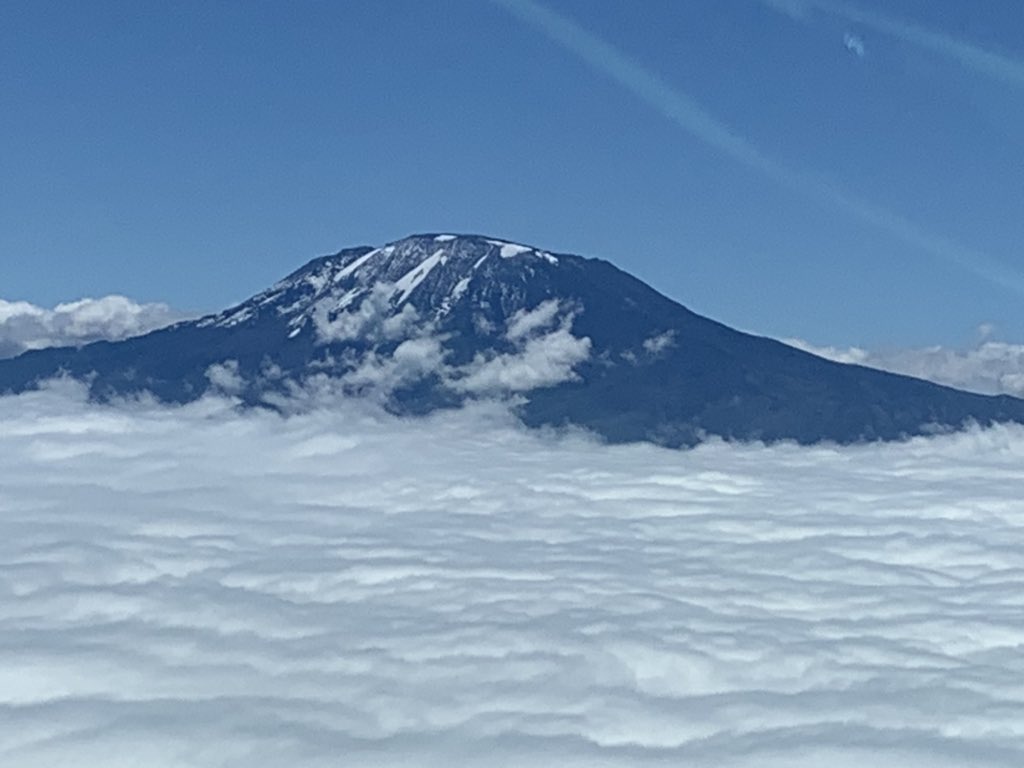MOUNT KILIMANJARO CLIMBING PACKING GEARS
What should I Pack for Kilimanjaro Trekking?
Trekking Boots.
Make sure that you come with the right boots, that have good ankle support, are waterproof, semi-rigid soles, are warm and most of all comfortable for your feet. hiking boots are better.
The best way to test good fit is to place your foot in a boot and slide it all the way forward until your toes hit the front of the boot (make sure you are wearing an average cushioned sports sock). Then take your index finger and slide it down the back of the boot between your heal and the boot support.
A perfect fitting boot will allow you to squeeze your finger in without too much resistance. If you cannot squeeze your index finger down the back of the boot, then unfortunately the boot is too small. If you find that your index finger fits too easily into the back of the boot, then the boot is likely too big. A snug fit, with your index finger in the back of the boot, is just right.
Note: this is not a science, but a good approximation for good fitting boots.
Preparations for Trekking
Please read this carefully and make sure you have gathered everything before you depart on your trip.
How Should You Prepare for Summiting Mount Kilimanjaro? This list covers what gear you will need to bring, physical training, Tanzania entry requirements (passport & visa), immunizations and vaccinations, and travel insurance.
The most important thing that you can bring to help you succeed in summing Mt Kilimanjaro is a positive attitude.
The golden rule here is to pack as lightly as possible. You will have a porter carrying a lot of these items, but it is important to pack lightly so they can carry additional items that will be necessary for the climb. Plus, you don’t want to be stuck with a lot of heavy baggage that you probably won’t use.
Lights on Africa Destinations & Safaris will provide at no additional cost communal equipment (tents, food, cooking items, etc.).
-Below is a gear-list of required, recommended and optional items for you to bring on your climb.
Technical Clothing:
1 – Light to Medium Waterproof Jacket, breathable with hood (It is very likely to rain on one or multiple days of the climb)
1 – Insulated Jacket, synthetic or down (to keep you warm when the sun isn’t shining)
1 – Soft Jacket, fleece or soft-shell (We recommend this for layers to help you keep warm without getting too hot)
2 – Long Sleeve Shirt, light-weight, moisture-wicking fabric
1 – Short Sleeve Shirt, light-weight, moisture-wicking fabric
1 – Waterproof Pants, breathable (side-zipper recommended)
2 – Hiking Pants (convertible to shorts recommended)
1 – Fleece Pants
1 – Shorts (optional)
1 – Long Underwear (moisture-wicking fabric recommended)
3 – Underwear, briefs (moisture-wicking fabric recommended)
2 – Sport Bra (women)
Headwear
1 – Brimmed Hat(for sun protection)
1 – Knit Hat (for warmth)
1 – Balaclava, for face coverage (optional)
1 – Bandana (optional)
Hand wear
1 – Warm Gloves (waterproof recommended)
1 – Glove Liners, thin, synthetic, worn under gloves for added warmth (optional)
Footwear
1 – Hiking Boots, warm, waterproof, broken-in, with spare laces (If you purchase new boots please make sure to hike in them at least 5 or 6 times prior to leaving for Tanzania, new boots cause blisters!)
1 – Lightweight shoes, to wear at camp (optional)
3 – Hiking Socks, thick, wool or synthetic
3 – Sock Liners, tight, thin, synthetic, worn under socks to prevent blisters (optional)
1 – Gaiters, waterproof (optional)
1 – Lightweight ice grips for shoes like yaktrax (You will only need this if it snows and you will NOT NEED crampons)
Accessories
1 – Sunglasses or Goggles (Very Important! – The sun is extremely strong at 14,000+ ft, 4000+ Meters)
1 – Backpack Cover, waterproof (optional)
1 – Poncho, during rainy season (optional)
1 – Water Bottle (Nalgene, 32 oz.)
1 – Water Bladder (Camel back type, 2-3 liters)
1 – Towel, lightweight, quick-dry (optional)
1 – Pee Bottle, to avoid leaving tent at night (recommended)
Stuff Sacks or Plastic Bags, various sizes, to keep gear dry and separate
1 – Two Person Tent (Optional! Lights on Africa will provide a high quality 3-season tent for you, however, if you have a tent you love and it is high quality you can bring it for your personal use).
Equipment
1 – Sleeping Bag rated at a minimum of -15 degrees Celsius (5 degrees F),
1 – Lightweight / travel pillow / inflatable pillow
1 – Sleeping Bag Liner, for added warmth (optional)
1 – Trekking Poles (recommended)
1 – Head lamp, with extra batteries
1 – Backpack or Duffer bag, for porters to carry your equipment
1 – Small to Medium Day pack, for you to carry your personal gear (The porters will carry most of your gear and clothing, this bag is for water, a camera, snacks, sunscreen, etc.)
Other Toiletries Prescriptions and Visa Requirements
Sunscreen (At Least 30 SPF
Prescriptions (Diamox High Altitude Medications, Other Personal Medications)
Lip Balm
Insect Repellent, containing DEET (You won’t have mosquitos after the first 2 days because they do not live at the higher altitude).
First Aid Kit (Antibiotic cream, adhesive bandages
Ibuprofen or Pain Reliever
Hand Sanitizer
Toilet Paper
Wet Wipes (recommended)
Energy Bars, Snacks, light-weight, high calorie, high energy (optional)
Camera, with extra batteries (optional)
Paperwork
Trip Receipt/Invoice
Passport
Visa (Can be purchased upon available at JRO, Very Important please bring US Dollars!)
Immunization Papers (Immunization Papers Will Be Checked Upon Arrival at JRO Airport)
Travel Insurance Documents:-
Please Read!
The most common mistake that climbers make when climbing Kilimanjaro is that they over pack and bring way too much gear.
Be selective in what you bring with you. Please note that our porters are limited to carrying (15 kg or 33 lbs) of your personal belongings.
The porters will carry almost all of your personal gear between campsites. The majority of your personal items should be placed into the backpack or duffel bag, including the sleeping bag, but it is OK to pack the sleeping bag separately if necessary. If you rent a sleeping bag from us, note that the bag weighs is 3 kgs. And this weight does count against the 15 Kilos or 33 lbs.
Our porters will place your duffel bag with your belongings and sleeping bag into a large, sturdy, waterproof bag with a roll-top closure. You will have access to your belongings at the campsites every night. The porters typically will arrive to the next campsite before you arrive so you will have your access to your belongings except when you are hiking.
If you have excessive weight, you will be required to hire and pay for an additional porter. It is rare to require an extra porter and should happen only in special cases, such as for carrying extensive photography equipment. If you require an additional porter please advise Lights on Africa Destinations & Safaris so we can make additional accommodations and bring additional food for the additional porter.
You are expected to come prepared and bring everything you need.
We understand you might be coming from a Safari or another part of Africa and will have additional baggage with you. All extra luggage items that you do not need for your climb, such safari clothing, Zanzibar gear and equipment will be securely kept at the hotel.
Please note that plastic, recyclable water bottles are not allowed in the park, due to past problems with litter. Please bring a Nalgene bottle, water bladders, or similar devices. Please bring enough capacity to be able to carry 3-4 liters of water with you at all times.
Please keep in mind that Mount Kilimanjaro is 19,241 ft tall (5895 Meters) and drinking alcohol and high altitude do not mix well. We will celebrate your successful climb to the top of Kilimanjaro with beer and alcohol at the hotel, after the climb.
Unfortunately checked luggage on airplanes can get lost or delayed on the way to Tanzania. You should prepare for this possibility by wearing or carrying on the items that are most essential to your climb. If your luggage is lost or delayed; most clothing, gear and equipment can be replaced in Tanzania prior to your climb, but there are some things that you might not be able to replace.
Tipping guidelines for Guides, Cooks and Porters
Whether you are climbing Mt. Kilimanjaro or going on safari or doing both, all of the guides and porters salaries have been paid as part of your package. Tipping is not included but is recommended and highly appreciated. Here are some basic guidelines. Remember, if you’re not happy with the service, you can tip less.
Each group of 2 or more will have a head guide, an assistant guide, a cook, and 3-5 porters per climber. The head guide manages his own team who work together on every climb. Therefore, payment can be made to the head guide who will then distribute the tips to each person. It works best if you collect the group’s tips and then have one person pay the head guide at the Gate/Hotel after the climb. You may want to write down on a paper exactly what amount you want each person to receive and tell them while all together on the last day at the gate or at the Hotel. You can use US dollars or Local currencies to pay the tip.
Head guide: Tip $25- $30 for each day you are on the mountain
Assistant guide: $15-$20 for each day on the mountain. There is some flexibility here, depending how helpful your assistant guide was.
Cook: $15-$20 for each day on the mountain. Often acts as a porter and a cook.
Porters: $10 – $15 for each porter and for each day on the mountain. You will have 3-5 porters per climber unless you bring extra gear that may require extra porters
For more transparency, you can tell all the team the amount that you paid for the porters.
Note: Your tips for the guide, assistant guide and cook should be shared among your entire group. Each person should be responsible for tipping their personal porters as well as contributing towards the other guides and cooks. Our recommendation is to use these figures as a guideline, it is not a policy. These amounts may seem like a lot before the climb, but trust us, once you are there, you will appreciate our service.
Lights on Africa Destinations & Safaris recommends that you wear one complete hiking outfit on the plane, including a long sleeve shirt, hiking pants, underwear, socks, and hiking boots. Your carry-on baggage, you should bring your small backpack, waterproof jacket and pants, insulated jacket, fleece pants, toiletries, medications, camera and all governmental paperwork. Airline regulations do not allow you to carry trekking poles on the plane. Make sure you do wear/carry your hiking boots; wearing a different pair of boots on your climb, will likely cause blistering.
Lights on Africa Destinations & Safaris is a very professional outfit and we will be prepared to get you to the top of Mount Kilimanjaro and back to the bottom safely. We have professional guides that know the mountain very well and most of them have summited Kilimanjaro over 100 times. You can sleep easy knowing that you have selected Lights on Africa Destinations & Safaris and we will be ready and excited to share this amazing adventure with you!
Contact Lights on Africa for more information.
WhatsApp: +255789762924


